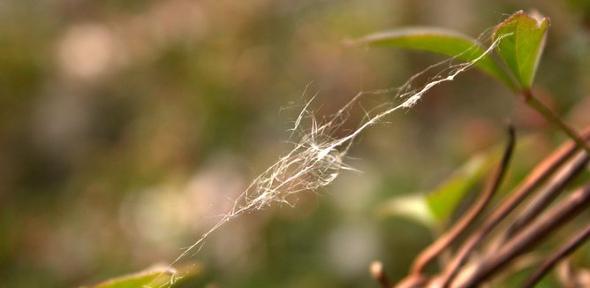
Dr Michelle Oyen, lecturer in Mechanics of Biological Materials at the Department of Engineering, looks at just how true the myth is that spider silk is stronger than steel in this article for web-based news site The Conversation.
Spider silk is not stronger than steel. But that shouldn’t stop us from studying it, or from thinking of it as a wonder material.
Dr Michelle Oyen
You must have heard that spider silk is stronger than steel. We all want to believe that there are wonder materials in nature that are far superior to human-made ones. But the problem with statements that sound too good to be true is that they usually are.
Spider silk is not stronger than steel. But that shouldn’t stop us from studying it, or from thinking of it as a wonder material.
At best, spider silk might compare to steel when it comes to tensile strength, which is the largest stress that a material can withstand before breaking. For one variety of spider silk the value of tensile strength is just above 1 GPa, a unit of measuring force per unit area. That equates to a mid-range value for steel, where strengths range from 0.2 GPa to nearly 2 GPa.
Tensile strength is only one critical property. The stiffness of silk, which is its ability to deform elastically when force is applied, is many times less than that of steel. Where spider silk seems to beat steel by a large margin is its density, which is almost six times less. On a per-weight basis then, silk starts to look more interesting, with the ratio of strength to density exceeding that of steel.
There are many applications for which this combination of strength and low density are required. The new 787 Dreamliner airplane, for instance, is largely made from composite materials, where many different materials are combined to give the right combination of properties.
Another reason why spider silk is enthuastically studied is because of our interest in mimicking nature through “biomimicry”. The key difference between natural materials and man-made ones is not so much about physical properties. It’s about how they are made.
Spider silk is a protein, and proteins are formed inside of living cells. A process that happens at body temperature, unlike the manufacturing of steel, which happens in a furnace. The magic of spider silk has everything to do with the transmission of information through DNA. Human engineering is adept at using more energy to solve problems. Nature does it through the use of better information.
Also proteins are made of abundant elements such as carbon, hydrogen, oxygen and nitrogen, and the only byproduct of the reaction that makes proteins is water. So natural materials such as spider silk can claim to be “environmentally friendly”, because they use less energy and abundant elements, making the processing superior to most engineering materials.
Spider silk, then, is stronger than steel on a per weight basis while being very environmentally friendly. This may not have the same pithy ring to it as “spider silk is stronger than steel”, but it tells a much more dramatic story about why the mimicry of natural materials is a rapidly growing area of materials science and engineering.
We are yet to be able to fully understand how spider silk is made. An attempt at commercialisation through “spider goats”, where a genetically modified goat produced milk containing an extra protein that could be extracted and spun into spider silk thread, resulted in bankruptcy. But hope remains that by studying how spider silk delivers its strength through a sequence of genes present in spider DNA, engineers will one day be able to build airplanes and other high-performance devices using planet-sparing materials rich in information and low in energy.
Michelle's article in The Conversation can be viewed here and her own website here.

